Amazing underwater opening (10 photos)
 Bashny.Net
Bashny.Net
It's amazing what we find in the depths of the sea. Every shipwreck discovery is exciting, but sometimes stumble upon divers objects that initially may not be anything to do with water. From the locomotives of the 19th century to the ancient cities that previously lived only through legends, the ocean is a huge treasure chest filled with pearls of history. And given the fact that people are able to study while only 5 to 7 percent of the seabed, who knows what else may be out there hiding.
10. German bomber, who was considered a legend
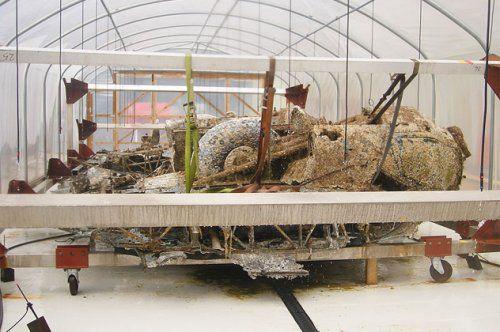
17 Dornier (Dornier 17) was a German bomber who participated in World War II, the Battle of Britain (Battle of Britain) and "London blitz» (Blitz), despite the fact that its production was halted in 1940. Despite the fact that it was built more than 2,000 aircraft, none of them survived after 1952, when the last of them destroyed by the Finnish aviation. However, the Dornier 17, who was hit by 26 August 1940 fighter Difayent (RAF Defiant), was discovered by divers in the sand Goodwin (Goodwin Sands), close to Kent, England in 2008.
The plane was shot down pilot Desmond Hughes (Desmond Hughes) and his gunner, Sergeant Fred Gash (Fred Gash), during a raid committed to lure the enemy planes in the air. Dornier 17, which is in line with reports of divers, is in excellent condition, was raised from the sea in 2013, the Air Force Museum in North London in the project, which cost 1,003,440 dollars. The restoration, which will take two years, will be held at the Museum of the Royal Air Force at Cosford (Cosford), Shropshire (Shropshire), United Kingdom. 9. Uluburun shipwreck (Uluburun Shipwreck)
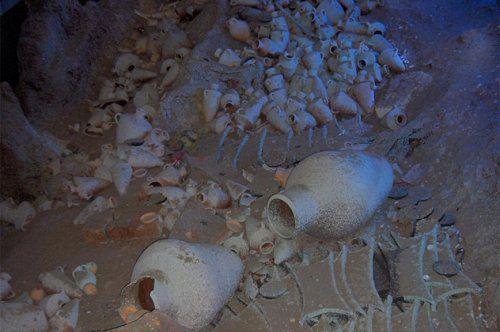
Photo: George Dzhansun (Georges Jansoone)
Debris Uluburun shipwreck was found quite by accident, a diver involved in the collection of marine sponges in 1982, off the southwest coast of Turkey. The ship, belonging to the 14th century BC, built of cedar and is one of the oldest ships in the world. On board the ship, among other cargo, were 10 thousand tons of copper, Egyptian jewelry, ivory, the oldest intact glass ingots and Italian sword. The discovery has allowed historians to learn much more about the trade in the Mediterranean. The variety of goods on board shows that the Mediterranean Sea was the site of a much more active trading than originally anticipated.
The knowledge gained in the study of the ship were so important that «Scientific American» included this finding in the list of 10 greatest archaeological discoveries of the 20th century. Debris rise to the surface for 10 years, a period of three excavations and Uluburun shipwreck was the deepest ship fully raised to the surface at that point. On the recovery of the wreckage it took as many as 22,413 dives, but Uluburun shipwreck was lifted entirely. Today it is the Museum of Underwater Archaeology Bodrum (Bodrum Museum) in southern Turkey.
8. Two car that could be a clue for cases of 40-year-old
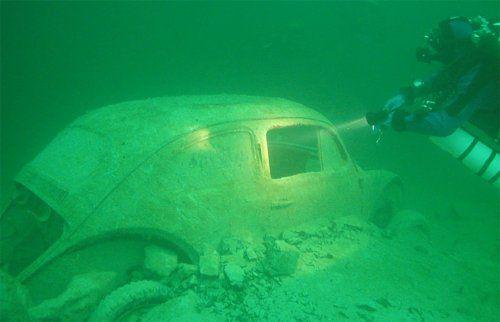
Photo: Mayor R. Shloffel (Achim R Schloeffel)
In September 2013, police divers experiencing new sonar equipment in the lake of Oklahoma, found two cars that were under water for 40 years. Police initially concluded that the cars were stolen and then just dumped into the lake. When the cars were opened, it became apparent darker and mysterious cause of their being under water - in every car there were three skeletons.
The bodies inside one of the cars of the brand «Chevrolet Camaro» 1969, is believed to belong to the three teens who were last seen more than 40 years ago. They belong to 16-year-old Jimmy Allen Williams (Jimmy Allen Williams), who was the owner of the car, and his 18-year-old friend, Thomas Michael Rios (Thomas Michael Rios) and Gail Johnson Leah (Leah Gail Johnson). That night, when they were gone, they were allegedly sent to a football match.
In the second car, Chevrolet 1950, is thought to have bodies of three missing adults, which also was the last time you saw 40 years ago, 58-year-old Nora Duncan (Nora Duncan), her friend 69-year-old Alvi Porter ( Alvi Porter), and other Cleburne Gemmok (Cleburn Hammock). Forensic experts will take several years to identify the skeletons with certainty, but after 40 years, finding gives families of missing a ray of hope for a decent farewell.
7. The wreckage of ships Maharatta (SS Mahrattas)

Goodwin Sands on the coast of Kent, is a frequent venue finding the wreckage of various ships. This area is the narrowest part of the English Channel, as well as the busiest shipping lane in the world. In the region there are about 1000 registered shipwrecks, with many others still potentially remain undetected. Two of the ships are one of the most bizarre stories of navigational accidents - two ships Maharatta.
Maharatta first steamboat was launched in 1891 and ran aground in 1907 after being taken the wrong course. After local residents looted its cargo, the wind tilted the ship, which fell on its side and sank. Maharatta second ship was launched in 1917 and ran aground on the Goodwin Sands in 1939. When rescue crews found the ship, they were surprised to see that he got stuck on the first Maharatta. This story is even more incredible by the fact that both ships sailed the same route from Calcutta to London. In 2008, the ferry bumped into one of them in bad weather. However, it did not indicate which of the two was responsible Maharatt.
6. Fighter-bomber McDonnell Douglas F-4 "Phantom» II (F-4 Fighter Jet)

Fighter-bomber McDonnell Douglas F-4 "Phantom» II is buried in the sand off the coast of the Philippines in the Bay of Subic Bay (Subic Bay), at a depth of 40 meters. When divers found wreckage from the crash damage caused obvious question: How did he get there? The seabed in this area is a frequent site of detection of aircraft - a lot of planes belonging to the Allied and Japanese troops fought in the region during the Second World War. However, the discovery of a relatively modern jet fighter McDonnell Douglas F-4 "Phantom» II, which was produced from 1958 to 1981, is quite rare.
One theory is that the plane just fell from the aircraft carrier. Until recently, quite often with the damaged aircraft shot all the useful parts and pushed them to the carriers to free up space on the deck. Of course, flooding fighter worth millions of dollars is now clearly not discouraged, but then there were other times. Another theory is that he was the victim of a fire aboard the USS Forrestal (USS Forrestal) in 1967 during the Vietnam War, in which seven were damaged fighter-bombers McDonnell Douglas F-4 "Phantom» II. Perhaps the truth will never be revealed, but it still remains an interesting mystery.
5. Record submarine Japan

Huge class submarine I-400 was detected in August 2013, the 700 meters underwater off the coast of Hawaii. «I-400" was a huge Japanese submarine of World War II, designed for the transport of the three bombers, hydroplanes that could strike at an area outside the range of reach of ordinary Japanese aircraft. The Japanese were planning to create a fleet of 18 submarines, which could potentially run strikes on US cities, but these plans were never implemented, and only three were built of seaplanes. Even these three are not used for other purposes, they are usually used to transport fuel to the islands in the Pacific Ocean.
With its length of 122 meters, these ships were the longest submarine in the world at that time, and the range of their reach was 60 350 kilometers. They have not been surpassed in size and range up to the appearance of US nuclear submarines in the late 1950s and early 1960s. The US Navy took I-400 at the end of the war and spent considerable resources to study the secrets of a sunken submarine. Following a request from the Soviet Union on the study of I-400 in 1946, the Americans launched three torpedoes into it and sent back into the depths of the ocean to the Soviet Union had no opportunity to study it.
4. Two of the engine, which nobody knew
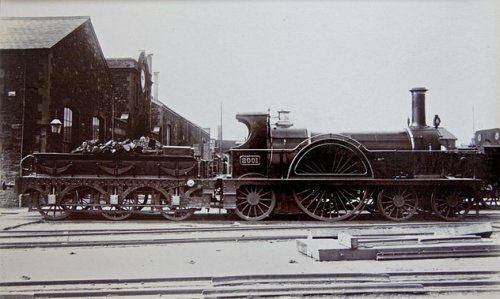
Photo: Tony Hisgett (Tony Hisgett)
In 1985, Paul Hepler (Paul Hepler) mapping of the ocean floor off the coast of New Jersey with the help of a magnetometer, when he found two large metal object. Not knowing what they were, he ducked down to look, but could not see anything. When he later returned to the place, he found that there were two locomotive 1850, which stood side by side at a depth of 27, 5 meters under water. Even more incredible is the fact that no one knows how they got there. There is not even any record of their construction, not something that they were lost at sea.
There are several theories about how they got there: locomotives could lose the ship in a storm, to reduce the load, or they could just fall off. Given the fact that they were built even before railroads linked the whole of America, it is believed that they were transported in the Middle Atlantic states, and that is why they were transported by boat. However, scientists know that it was the model locomotives «Planet Class 2-2-2 Ts», almost obsolete even at the time when they were built and very rare today. Despite the fact that they were covered by more than 160 years of rust, they are fairly well preserved, and is now scheduled to lift them to the land for conservation.
3. Lost Pagodas of Mahabalipuram (Lost Mahabalipuram Pagodas)

For a long time the people of the Indian city of Mahabalipuram talked about the seven pagodas are so great that the gods became jealous of the sea and forced to swallow six of them. However, historians have always believed that the remaining onshore pagoda was the only one of its kind, rejecting history as a local legend. However, during the tsunami on Boxing Day (Boxing Day) in 2004, the water receded 500 meters, opening the legendary Pagoda for a short period of time.
When the water rushed back, she washed the cake structures, opening them for the first time in many centuries. Local fishermen have organized teams of divers to the place where they were impressed by the findings. Expedition leader, Monty Halls (Monty Halls) said: "Initially, we have a sense of mistrust prevailed. The sheer scale of the place was very impressive. " The findings add credibility to the legend of the pagodas, and became evidence that they actually could be absorbed by the sea, as the legend. More importantly, this place will be a rich source of knowledge about the Pallava (Pallava).
2. Sphinx

Photo: Roland Unger (Roland Unger)
In early 2014, underwater archaeologists have discovered a sphinx off the coast of the Bahamas while exploring the wreckage of an ancient shipwreck. Despite the difficulties in studying the statue due to erosion and coral, scientists announced that she almost certainly has a Middle Eastern origin. In addition, the limestone from which it was made, is believed to originate from Wadi Rahan (Wadi Rahanu), the Egyptian region, famous for its limestone quarries from 3500 BC. It is believed that the Sphinx lay there for about 2,500 years and probably was part of the cargo on the ship, which was studied initially.
According to most historians, the ancient Egyptians were not good sailors, so the presence of the Sphinx is particularly strange. In order to determine the origin of the vessel necessary to conduct more studies of the Sphinx and the ship. This will allow us to understand why and how the Sphinx was at the bottom of the Caribbean Sea. Unfortunately, based on the fact that the ship was badly damaged, the only thing we can learn from the striking findings for the moment is that the ship was made of cedar. It's not a lot, so it's possible that we will never solve the mystery of the underwater sphinx.
1. The mythical city
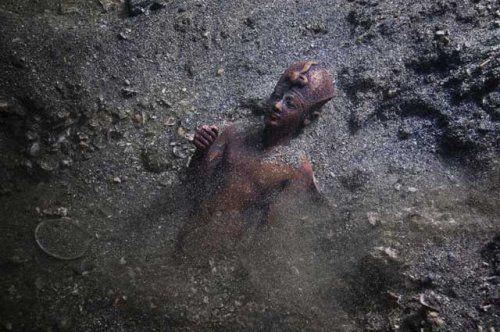
Has long been considered a myth, the city Heracleon (Heracleion) (the Greeks) and Tonis (Thonis) (the Egyptians) was rediscovered in the Bay of Aboukir (Aboukir), close to Egypt under 46 meters of water. It was found in 2000 after the remains buried under the sand and mud for 1,200 years. In connection with the mixture of artifacts found at the site, it is assumed that the city was a bustling commercial center, the main stop for merchant ships from Greece and Egypt. In this region, it was discovered 64 other wrecks, and 700 anchors. With space Heracleon raised massive statues, which are believed to be decorated temples in the city.
Among other artifacts were discovered coins, the balance from Greece and Egypt, as well as tables with the texts of the two civilizations. This finding makes it even more incredible is how she survived - artifacts, buried under layers of sand for nearly 1,200 years were not affected. According to calculations carried out, the discovery of secrets that poses a city can take up to 200 years.
10. German bomber, who was considered a legend

17 Dornier (Dornier 17) was a German bomber who participated in World War II, the Battle of Britain (Battle of Britain) and "London blitz» (Blitz), despite the fact that its production was halted in 1940. Despite the fact that it was built more than 2,000 aircraft, none of them survived after 1952, when the last of them destroyed by the Finnish aviation. However, the Dornier 17, who was hit by 26 August 1940 fighter Difayent (RAF Defiant), was discovered by divers in the sand Goodwin (Goodwin Sands), close to Kent, England in 2008.
The plane was shot down pilot Desmond Hughes (Desmond Hughes) and his gunner, Sergeant Fred Gash (Fred Gash), during a raid committed to lure the enemy planes in the air. Dornier 17, which is in line with reports of divers, is in excellent condition, was raised from the sea in 2013, the Air Force Museum in North London in the project, which cost 1,003,440 dollars. The restoration, which will take two years, will be held at the Museum of the Royal Air Force at Cosford (Cosford), Shropshire (Shropshire), United Kingdom. 9. Uluburun shipwreck (Uluburun Shipwreck)

Photo: George Dzhansun (Georges Jansoone)
Debris Uluburun shipwreck was found quite by accident, a diver involved in the collection of marine sponges in 1982, off the southwest coast of Turkey. The ship, belonging to the 14th century BC, built of cedar and is one of the oldest ships in the world. On board the ship, among other cargo, were 10 thousand tons of copper, Egyptian jewelry, ivory, the oldest intact glass ingots and Italian sword. The discovery has allowed historians to learn much more about the trade in the Mediterranean. The variety of goods on board shows that the Mediterranean Sea was the site of a much more active trading than originally anticipated.
The knowledge gained in the study of the ship were so important that «Scientific American» included this finding in the list of 10 greatest archaeological discoveries of the 20th century. Debris rise to the surface for 10 years, a period of three excavations and Uluburun shipwreck was the deepest ship fully raised to the surface at that point. On the recovery of the wreckage it took as many as 22,413 dives, but Uluburun shipwreck was lifted entirely. Today it is the Museum of Underwater Archaeology Bodrum (Bodrum Museum) in southern Turkey.
8. Two car that could be a clue for cases of 40-year-old

Photo: Mayor R. Shloffel (Achim R Schloeffel)
In September 2013, police divers experiencing new sonar equipment in the lake of Oklahoma, found two cars that were under water for 40 years. Police initially concluded that the cars were stolen and then just dumped into the lake. When the cars were opened, it became apparent darker and mysterious cause of their being under water - in every car there were three skeletons.
The bodies inside one of the cars of the brand «Chevrolet Camaro» 1969, is believed to belong to the three teens who were last seen more than 40 years ago. They belong to 16-year-old Jimmy Allen Williams (Jimmy Allen Williams), who was the owner of the car, and his 18-year-old friend, Thomas Michael Rios (Thomas Michael Rios) and Gail Johnson Leah (Leah Gail Johnson). That night, when they were gone, they were allegedly sent to a football match.
In the second car, Chevrolet 1950, is thought to have bodies of three missing adults, which also was the last time you saw 40 years ago, 58-year-old Nora Duncan (Nora Duncan), her friend 69-year-old Alvi Porter ( Alvi Porter), and other Cleburne Gemmok (Cleburn Hammock). Forensic experts will take several years to identify the skeletons with certainty, but after 40 years, finding gives families of missing a ray of hope for a decent farewell.
7. The wreckage of ships Maharatta (SS Mahrattas)

Goodwin Sands on the coast of Kent, is a frequent venue finding the wreckage of various ships. This area is the narrowest part of the English Channel, as well as the busiest shipping lane in the world. In the region there are about 1000 registered shipwrecks, with many others still potentially remain undetected. Two of the ships are one of the most bizarre stories of navigational accidents - two ships Maharatta.
Maharatta first steamboat was launched in 1891 and ran aground in 1907 after being taken the wrong course. After local residents looted its cargo, the wind tilted the ship, which fell on its side and sank. Maharatta second ship was launched in 1917 and ran aground on the Goodwin Sands in 1939. When rescue crews found the ship, they were surprised to see that he got stuck on the first Maharatta. This story is even more incredible by the fact that both ships sailed the same route from Calcutta to London. In 2008, the ferry bumped into one of them in bad weather. However, it did not indicate which of the two was responsible Maharatt.
6. Fighter-bomber McDonnell Douglas F-4 "Phantom» II (F-4 Fighter Jet)

Fighter-bomber McDonnell Douglas F-4 "Phantom» II is buried in the sand off the coast of the Philippines in the Bay of Subic Bay (Subic Bay), at a depth of 40 meters. When divers found wreckage from the crash damage caused obvious question: How did he get there? The seabed in this area is a frequent site of detection of aircraft - a lot of planes belonging to the Allied and Japanese troops fought in the region during the Second World War. However, the discovery of a relatively modern jet fighter McDonnell Douglas F-4 "Phantom» II, which was produced from 1958 to 1981, is quite rare.
One theory is that the plane just fell from the aircraft carrier. Until recently, quite often with the damaged aircraft shot all the useful parts and pushed them to the carriers to free up space on the deck. Of course, flooding fighter worth millions of dollars is now clearly not discouraged, but then there were other times. Another theory is that he was the victim of a fire aboard the USS Forrestal (USS Forrestal) in 1967 during the Vietnam War, in which seven were damaged fighter-bombers McDonnell Douglas F-4 "Phantom» II. Perhaps the truth will never be revealed, but it still remains an interesting mystery.
5. Record submarine Japan

Huge class submarine I-400 was detected in August 2013, the 700 meters underwater off the coast of Hawaii. «I-400" was a huge Japanese submarine of World War II, designed for the transport of the three bombers, hydroplanes that could strike at an area outside the range of reach of ordinary Japanese aircraft. The Japanese were planning to create a fleet of 18 submarines, which could potentially run strikes on US cities, but these plans were never implemented, and only three were built of seaplanes. Even these three are not used for other purposes, they are usually used to transport fuel to the islands in the Pacific Ocean.
With its length of 122 meters, these ships were the longest submarine in the world at that time, and the range of their reach was 60 350 kilometers. They have not been surpassed in size and range up to the appearance of US nuclear submarines in the late 1950s and early 1960s. The US Navy took I-400 at the end of the war and spent considerable resources to study the secrets of a sunken submarine. Following a request from the Soviet Union on the study of I-400 in 1946, the Americans launched three torpedoes into it and sent back into the depths of the ocean to the Soviet Union had no opportunity to study it.
4. Two of the engine, which nobody knew

Photo: Tony Hisgett (Tony Hisgett)
In 1985, Paul Hepler (Paul Hepler) mapping of the ocean floor off the coast of New Jersey with the help of a magnetometer, when he found two large metal object. Not knowing what they were, he ducked down to look, but could not see anything. When he later returned to the place, he found that there were two locomotive 1850, which stood side by side at a depth of 27, 5 meters under water. Even more incredible is the fact that no one knows how they got there. There is not even any record of their construction, not something that they were lost at sea.
There are several theories about how they got there: locomotives could lose the ship in a storm, to reduce the load, or they could just fall off. Given the fact that they were built even before railroads linked the whole of America, it is believed that they were transported in the Middle Atlantic states, and that is why they were transported by boat. However, scientists know that it was the model locomotives «Planet Class 2-2-2 Ts», almost obsolete even at the time when they were built and very rare today. Despite the fact that they were covered by more than 160 years of rust, they are fairly well preserved, and is now scheduled to lift them to the land for conservation.
3. Lost Pagodas of Mahabalipuram (Lost Mahabalipuram Pagodas)

For a long time the people of the Indian city of Mahabalipuram talked about the seven pagodas are so great that the gods became jealous of the sea and forced to swallow six of them. However, historians have always believed that the remaining onshore pagoda was the only one of its kind, rejecting history as a local legend. However, during the tsunami on Boxing Day (Boxing Day) in 2004, the water receded 500 meters, opening the legendary Pagoda for a short period of time.
When the water rushed back, she washed the cake structures, opening them for the first time in many centuries. Local fishermen have organized teams of divers to the place where they were impressed by the findings. Expedition leader, Monty Halls (Monty Halls) said: "Initially, we have a sense of mistrust prevailed. The sheer scale of the place was very impressive. " The findings add credibility to the legend of the pagodas, and became evidence that they actually could be absorbed by the sea, as the legend. More importantly, this place will be a rich source of knowledge about the Pallava (Pallava).
2. Sphinx

Photo: Roland Unger (Roland Unger)
In early 2014, underwater archaeologists have discovered a sphinx off the coast of the Bahamas while exploring the wreckage of an ancient shipwreck. Despite the difficulties in studying the statue due to erosion and coral, scientists announced that she almost certainly has a Middle Eastern origin. In addition, the limestone from which it was made, is believed to originate from Wadi Rahan (Wadi Rahanu), the Egyptian region, famous for its limestone quarries from 3500 BC. It is believed that the Sphinx lay there for about 2,500 years and probably was part of the cargo on the ship, which was studied initially.
According to most historians, the ancient Egyptians were not good sailors, so the presence of the Sphinx is particularly strange. In order to determine the origin of the vessel necessary to conduct more studies of the Sphinx and the ship. This will allow us to understand why and how the Sphinx was at the bottom of the Caribbean Sea. Unfortunately, based on the fact that the ship was badly damaged, the only thing we can learn from the striking findings for the moment is that the ship was made of cedar. It's not a lot, so it's possible that we will never solve the mystery of the underwater sphinx.
1. The mythical city

Has long been considered a myth, the city Heracleon (Heracleion) (the Greeks) and Tonis (Thonis) (the Egyptians) was rediscovered in the Bay of Aboukir (Aboukir), close to Egypt under 46 meters of water. It was found in 2000 after the remains buried under the sand and mud for 1,200 years. In connection with the mixture of artifacts found at the site, it is assumed that the city was a bustling commercial center, the main stop for merchant ships from Greece and Egypt. In this region, it was discovered 64 other wrecks, and 700 anchors. With space Heracleon raised massive statues, which are believed to be decorated temples in the city.
Among other artifacts were discovered coins, the balance from Greece and Egypt, as well as tables with the texts of the two civilizations. This finding makes it even more incredible is how she survived - artifacts, buried under layers of sand for nearly 1,200 years were not affected. According to calculations carried out, the discovery of secrets that poses a city can take up to 200 years.
Tags
See also
Unexplained mysteries of the world (20 photos)
American soldiers of the Red Army (12 photos)
Antarctica. Mysteries
Fatalities adrenaline junkies
The life lived Leo (21 photos)
10 common products that were invented by accident (10 photos)
5 mysterious stories and simple explanations (7 photos)
Mind Games (17 photos)
Satellite - it is very easy
Photos that shook the world

















